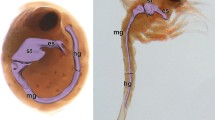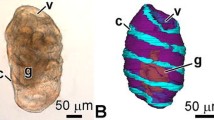Summary
The anatomy and histology of the digestive organs in the gaster ofCamponotus pennsylvanicus males are described for those taken from nests during the month of May and for those captured when they were swarning for the nuptial flight in July.
The arrangement of the organs and their histology are similar to that which has already been described for theCamponotous workers. In the male ventriculus, however, the epithelial cells are taller and their shapes somewhat different from those in the worker. There is food in all themale gastral digestive organs.
Most males dissected had 18 Malpighian tubules, some had 20, and one had 23; in this latter case, one was branched.
In the swarming males most of the gastral digestive organs are collapsed or reduced in diameter. The crop, proventriculus, and ventriculus are practically lying on the floor of the first three gastral segments; this condition leaves large spaces in the dorsal anterior end of the gaster. The system is empty of food. The epithelial cells of the ventriculus are degenerating, and the lumen of this organ is filled with basophilic-staining granules.
There are differences between the midguts ofC. pennsylvanicus, here described, and ofAnergates atratulus, described byMeyer (1955).
Résumé
Description anatomique et histologique des organes du tube digestif deCamponotus pennsylvanicus mâles pris dans leurs nids durant le mois de mai ou saisis pendant l'essaimage nuptial en juillet.
La position des organes et leur histologie sont semblables à celles qui ont été déjà décrites pour lesCamponotus ouvrières. Dans le ventriculus du mâle, pourtant, les cellules épithéliales sont plus longues et leur forme est quelque peu différente de celles de l'ouvrière. Tous les organes digestifs gastriques du mâle contiennent de la nourriture.
La plupart des mâles disséqués avaient 18 tubes de Malpighi; d'autres en avaient 20, un en avait 23; dans ce dernier, il y avait des tubulibranches.
Chez les mâles essaimants, la plupart des organes digestifs gastriques sont affaissés ou réduits en diamètre. Le jabot, le gésier et le ventriculus reposent pratiquement sur le fond des trois premiers segments gastriques; cette position libère de grands espaces dans la partie antéro-dorsale de l'abdomen. Le système digestif est vide de nourriture. Les cellules épithéliales du ventriculus sont en dégénérescence et la cavité de cet organe est remplie de grains intensément colorables par l'hématoxyline.
Il y a des différences entre le ventriculus deC. pennsylvanicus, décrit ici, et celui deAnergates atrautulus, décrit parMeyer (1955).
Zusammenfassung
Die Anatomie und Histologie der Verdauungsorgane im Gaster des männlichenCamponotus pennsylvanicus werden beschrieben auf Grund von Exemplaren, die im Mai aus dem Nest genommen und im Juli während der Hochzeitsflug gefangen wurden.
Die Verteilung der Organe und ihre Histologie sind ähnlich denen der Arbeiter vonCamponotus, die schon früher beschrieben wurden. Im männlichen Mitteldarm sind allerdings die Epithelzellen höher und ihre Form ist etwas anders als im Mitteldarm des Arbeiters. Nahrung ist vorhanden in allen männlichen Verdauungsorganen des Gasters.
Die meisten untersuchten Männchen hatten 18 Malpighische Gefässe, einige hatten 20 und eines hatte 23; in letzterem Falle war einer der Gefässe verzweigt.
In den Männchen in Hochzeitsflug sind die meisten Verdauungsorgane des Gasters zusammengefallen, oder ihr Durchmesser ist reduziert. Der Kropf, der Vormagen und der Mitteldarm liegen praktisch am Boden der drei ersten gastralen Segmente. Dieser Zustand läßt große Räume in der dorsalen Vorderende des Gasters frei. Das System enthält keine Nahrung. Die Epithelzellen des Mitteldarms degenerieren und das Lumen dieses Organs ist voll mit basophilen Körnchen.
Es bestehen Unterschiede zwischen dem hier beschriebenen Mitteldarm vonC. pennsylvanicus und dem vonAnergates atratulus, welcher vonMeyer (1955) beschrieben wurde.
Similar content being viewed by others
Literature Cited
1952.Eisner (T.), Wilson (E. O.). — The morphology of the proventriculus of a formicine ant (Psyche,59, 47–60).
1938.Forbes (J.). — Anatomy and histology of the worker ofCamponotus herculeanus pennsylvanicus De Geer (Formicidæ, Hymenoptera). [Ann. Ent. Soc. Amer.,31, 181–195].—Forbes (J.). 1952. The genitalia and terminal segments of the male carpenter ant,Camponotus pennsylvanicus DeGeer (Formicidæ, Hymenoptera) [Jour. N. Y. Ent. Soc.,60, 157–171].—Forbes (J.). 1954. The anatomy and histology of the male reproductive system ofCamponotus pennsylvanicus DeGeer (Formicidæ, Hymenoptera) [J. Morph.,95, 523–555].
1955.Meyer (G. F.). — Untersuchungen an einer parasitischer Ameisen (Anergates atratulus Schenck) [Insectes Sociaux,2, 163–171].
Author information
Authors and Affiliations
Rights and permissions
About this article
Cite this article
Forbes, J. Observations on the gastral digestive tract in the male Carpenter ant,Camponotus Pennsylvanicus degeer (Formicidae, Hymenoptera). Ins. Soc 3, 505–511 (1956). https://doi.org/10.1007/BF02226454
Issue Date:
DOI: https://doi.org/10.1007/BF02226454




